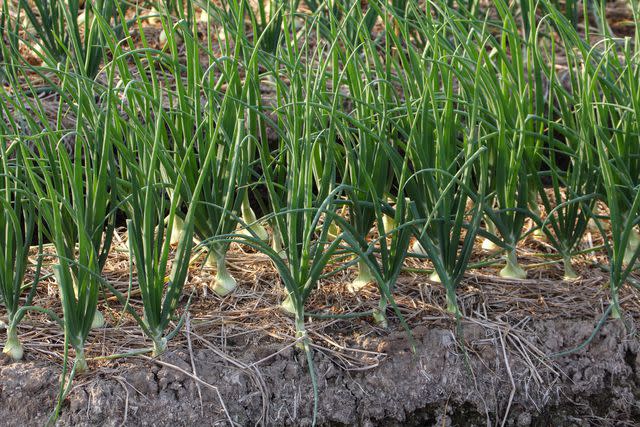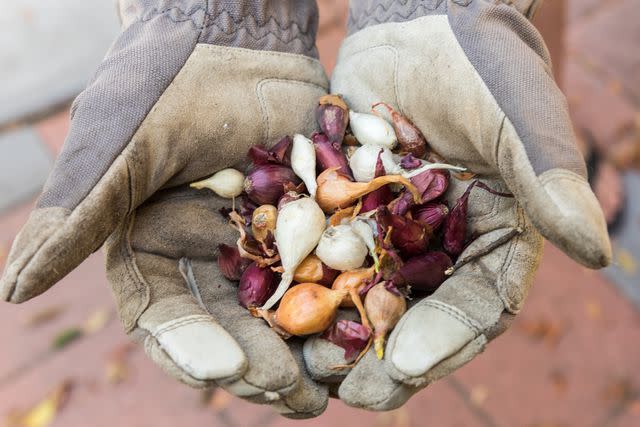How to Grow Winter Onions: Types and Care Tips
Overwinter onions for an earlier onion harvest next year
Winter onions is a general term for onions that are hardy enough to survive the winter, even in a northern climate. The onions are planted in the fall and remain in the ground over the winter. As temperatures warm up again, they restart growing until they are harvested in spring or early summer.
Read on to learn about the advantages of growing winter onions, different types, and planting and care tips.

TommyIX / Getty Images
Benefits of Growing Onions in the Wintertime
Winter onions come with several perks. They have a long growing season but unlike onions planted in the spring, it’s mostly hands-off time for the gardener. Weed growth is slowing down, so there is little to no weeding to do.
In the fall, precipitation is usually more frequent and abundant, so you don’t have to water. As temperatures drop, there are also fewer pests around that can attack the onions.
Instead of waiting for the soil to be workable in the spring to plant your onions, winter onions give you a great head start on the growing season—they are already established when they come out of dormancy.

Hana Richterova / Getty Images
Types of Winter Onions
In seed catalogs, you will likely find winter onions listed as overwintering onions or onions for autumn or fall planting. Just like onions that are planted in the spring, the length of day is an important criterion when selecting suitable onion varieties. Winter onions are typically intermediate or long-day onions.
The following are popular winter onion types:
Multiplier onions (Allium cepa var. aggregatum), also called potato onions, grow in clumps or clusters rather than as individual onions. The bulbs are small to medium in size. Multiplier onions are harvested as green onions or bulbs. They are planted from sets, not seeds, as they rarely produce flower stalks.
Egyptian walking onions (Allium x proliferum) are unusual bunching onions. In the summer, the plant produces clusters of bulblets at the top of tall stalks. The stalks bend over from the weight or eventually fall to the ground and the small bulbs root in a new location away from the original plant, thus their name “walking” onions., thus their name “walking” onions. The young shoots and stems of Egyptian walking onions are harvested as green onions and the bulblets are used like pearl onions.
‘Bridger’ is a yellow onion with large, semi-globe-shaped bulbs. This is an early-maturing variety that should be eaten soon after harvesting, as it does not store well.
‘Desert Sunrise’ is a red onion with flat-round bulbs 2 to 3 inches in diameter. Bolting (the premature development of a seed stalk) is a common problem when overwintering onions and this variety is considered highly bolt-resistant.
‘Talon’ is a medium to large globe cooking onion. Its thick skin makes is suitable for long-term storage.
‘Evergreen Hardy White’, an exceptionally cold-hardy scallion, is an heirloom variety that originated in Japan in the late 19th century. It is one of the earliest scallions to be harvested in the spring.
When to Plant Winter Onions
The timing depends on the planting method and your local climate. Winter onions can be planted from seed or onion sets, which is the preferred option for winter onions, as they produce more reliable results and higher quality.
Whichever method you choose, plant winter onions early enough so that the young plants have enough time to root and get established before the ground freezes. However, do not plant the onions too early, because they will be too far along and you risk bolting.

The Spruce / Jayme Burrows
For a general guideline, if your average winter temperatures are below 20 to 30 degrees F, start winter onions from seed in the late summer, or two to three months before the first frost date in your area. In a climate with milder winters, sow the seeds in the early fall.
If you are using onion sets, you have about four more weeks to get them in the ground.
Where to Plant Winter Onions
Choosing a planting site in full sun (at least six to eight hours per day) is very important for successfully growing winter onions because even in subzero winter temperatures, the sun heats the soil around the bulbs, aiding them to survive the chilly weather. In the spring, the soil in a location with full sun warms up and thaws faster so the onions break dormancy earlier.
The planting instructions for winter onions are the same as for onions planted in the spring.
How to Protect Winter Onions
The colder your winters, the more you will need to insulate the winter onions.
Right after planting, cover the area with about ½ inch of mulch suitable for vegetable gardens. After the onions have sprouted, add another inch of mulch but make sure not to bury the green tips. Gradually continue adding more mulch until there is about a 4-inch layer of mulch protecting the plants when the ground freezes.
In Zone 6 and below, it increases the survival rate of the onions if you protect them with a row cover or polytunnel or plant them in a cold frame.
A snow cover provides excellent insulation for the plants. In snow-less winters, have a supply of mulch and other materials for an extra layer of insulation ready.

MihailUlianikov / Getty Images
When to Harvest Winter Onions
Winter onions restart their growth once the temperatures warm up in the spring. The time of harvest depends on the variety and the climate. By April they are usually the size of scallions and by May, small bulbs have formed. In early to mid-summer, the bulbs are fully grown and ready for harvesting.
Onions are biennials that produce a flower stalk (scape) in their second year. Make sure to harvest them before that happens, or as soon as you see a scape form on the plant. Winter onions are prone to bolting, and even though the onions might not have the desired size, harvest them regardless, as the scape will affect the quality of the onion.
Read Next: How to Grow Candy Onions, a Sweet Hybrid That Will Thrive in Your Garden
Read the original article on The Spruce.

